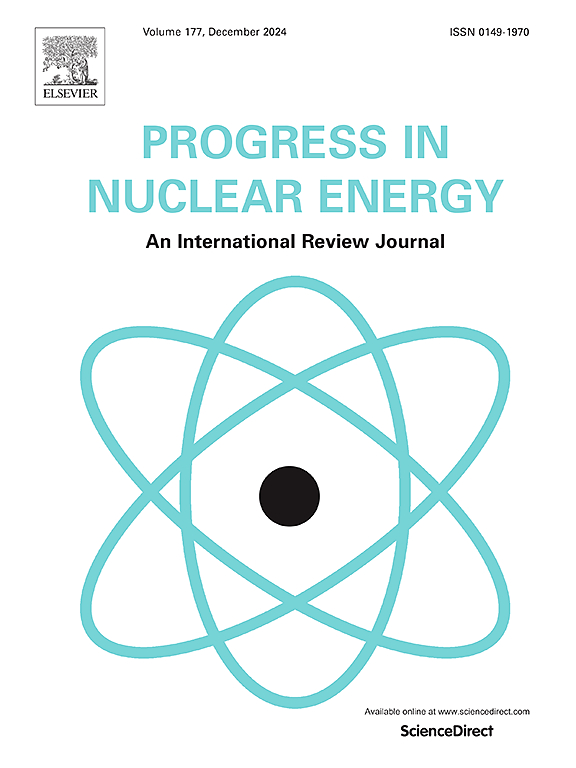基于蒙特卡罗方法和Wilks公式的岩心流分布优化的不确定性和敏感性分析
IF 3.3
3区 工程技术
Q1 NUCLEAR SCIENCE & TECHNOLOGY
引用次数: 0
摘要
堆芯流动分布优化对提高反应堆性能和安全性具有重要意义。然而,利用不确定性量化和敏感性分析来评估配流优化方案的可靠性是罕见的。以往的不确定性研究主要集中在与安全相关的反应堆参数上。本文考虑了优化目标(堆芯出口最大到最小温差和最大到平均温差)和流量分配的安全约束(MDNBR)作为关心的系统输出。考虑12个输入不确定参数,采用蒙特卡罗法和Wilks法对优化后系统的输出不确定性进行量化。结果表明,即使在最严格的条件下,优化后的系统仍显著优于非优化状态,MDNBR仍远高于安全限值。从而验证了优化方案的可靠性。此外,通过调整Wilks统计量的顺序和多次试验,比较了两种不确定性分析方法的性能。最后,使用Pearson、Spearman、Kendall和部分秩相关系数对蒙特卡罗结果进行敏感性分析。对堆芯出口温度不均匀性和通道温度影响最大的参数是径向功率分布。另一方面,轴向功率分布、系统流量、核心功率和径向功率分布与mnbr呈显著相关。本文章由计算机程序翻译,如有差异,请以英文原文为准。
Uncertainty and sensitivity analysis of core flow distribution optimization using Monte-Carlo method and Wilks' formula
The core flow distribution optimization is of great significance in enhancing reactor performance and safety. However, the use of uncertainty quantification and sensitivity analysis to assess the reliability of flow distribution optimization schemes is rare. Previous uncertainty studies mainly focus on safety-related reactor parameters. In this paper, the optimization objectives (the maximum-to minimum and the maximum-to-average temperature difference at the core outlet) and the safety constraint (MDNBR) for flow distribution were considered as the system outputs of interest. Taking twelve input uncertain parameters into account, Monte Carlo method and Wilks' method were utilized to quantify the output uncertainty of the optimized system. The results showed that, even under the most restrictive conditions, the optimized system still significantly outperformed the unoptimized state, with MDNBR remaining well above the safety limit. Therefore, the credibility of the optimization scheme was confirmed. Furthermore, through adjusting the order of the Wilks’ statistics and multiple trials, we compared the performance of the two uncertainty analysis methods. Lastly, sensitivity analysis based on Monte Carlo results was performed using Pearson, Spearman, Kendall, and partial rank correlation coefficients. The most influential parameter on core outlet temperature nonuniformity and the hottest channel temperature was the radial power distribution. On the other hand, axial power distribution, system flow, core power, and radial power distribution exhibit significant correlations with MDNBR.
求助全文
通过发布文献求助,成功后即可免费获取论文全文。
去求助
来源期刊

Progress in Nuclear Energy
工程技术-核科学技术
CiteScore
5.30
自引率
14.80%
发文量
331
审稿时长
3.5 months
期刊介绍:
Progress in Nuclear Energy is an international review journal covering all aspects of nuclear science and engineering. In keeping with the maturity of nuclear power, articles on safety, siting and environmental problems are encouraged, as are those associated with economics and fuel management. However, basic physics and engineering will remain an important aspect of the editorial policy. Articles published are either of a review nature or present new material in more depth. They are aimed at researchers and technically-oriented managers working in the nuclear energy field.
Please note the following:
1) PNE seeks high quality research papers which are medium to long in length. Short research papers should be submitted to the journal Annals in Nuclear Energy.
2) PNE reserves the right to reject papers which are based solely on routine application of computer codes used to produce reactor designs or explain existing reactor phenomena. Such papers, although worthy, are best left as laboratory reports whereas Progress in Nuclear Energy seeks papers of originality, which are archival in nature, in the fields of mathematical and experimental nuclear technology, including fission, fusion (blanket physics, radiation damage), safety, materials aspects, economics, etc.
3) Review papers, which may occasionally be invited, are particularly sought by the journal in these fields.
 求助内容:
求助内容: 应助结果提醒方式:
应助结果提醒方式:


